#ancient Chinese culture and folklore
Text

🌺 Hula Mulan 🗡️🐲
#Mulan#Fa Mulan#Disney fanart#late night drawing#Ming-Na Wen#Lea Salonga#Reflection#Honor To Us All#I’ll Make A Man Out of You#A Girl Worth Fighting For#True To Your Heart#hula#hula dancer#hula girl#princess#warrior#warrior princess#ancient China#ancient Chinese culture and folklore#Mulan 1998#Once Upon A Studio
4 notes
·
View notes
Text


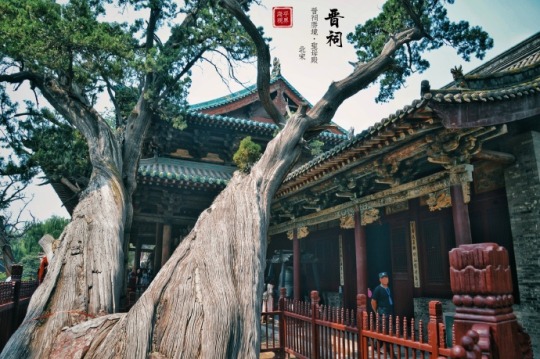
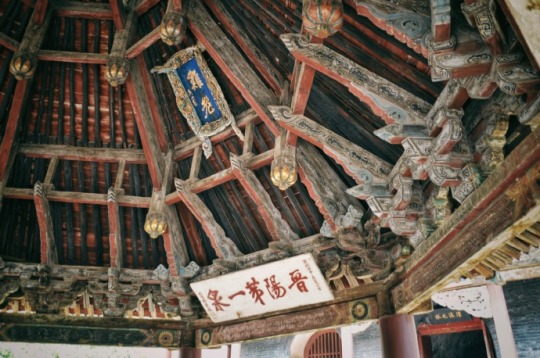
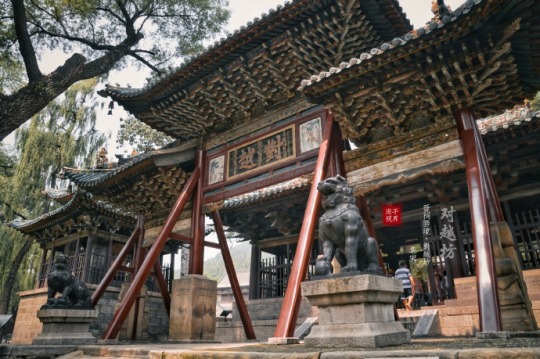




The Hall of the Holy Mother: One of the Oldest Places of Worship
The Hall of the Holy Mother (聖母殿) in Jinci Temple (晉祠), Shanxi. Built during the reign of Emperor Renzong (仁宗) of the Northern Song dynasty (1023-1032).
The hall is part of the ever evolving temple complex founded about one and a half thousand years ago. Over the centuries of countless transformations, it has accumulated buildings of various periods and styles.
The temple is dedicated to Shuimu (水母), The Old Mother of Waters, witch-goddess of Chinese lore, appearing in the form of a dragon, a snake or a charming lady with a sword and a yoke.
Photo: ©鱼雁江南, 雪夜魚舟
#ancient china#chinese culture#chinese mythology#taoism#chinese architecture#song dynasty#wooden architecture#wooden buildings#chinese customs#taoist#chinese folk religion#chinese temple#religious art#temple architecture#taoist deities#goddess#goddess worship#mother goddess#great mother#chinese folklore#dragon art#dragon
252 notes
·
View notes
Text
The Advisors Alliance Translation Post 2: “Husband, don’t cross the river. Husband, nonetheless, crossed the river.”
The Advisors Alliance 大军师司马懿之军师联盟 is a 2017 two-part Chinese TV series depicting the life of Sima Yi, a government official and military strategist who lived during the late Eastern Han Dynasty 东汉 (25 CE - 220 CE) and the Three Kingdoms Period 三国時代 (220 CE - 280 CE). [Wikipedia of the show’s first season]
The second part is titled Growling Tiger Hidden Dragon 虎啸龙吟 and keeps following Sima Yi’s life as he matures and becomes wiser [Link to the show’s second season’s MyDramaList page].
The Weibo account [Link] of the show made a series of posts in the style of small encyclopedias explaining different historical and cultural facts that where included in the series. The user @moononmyfloor compiled the 50 posts and asked me to translate them. This will be an ongoing series where I will do just that.
The posts are not in order of the episodes but I will provide the episode and season number to avoid confusion. If there are any mistakes in translation, do let me know in the comments or privately message me and I will do my best to fix them. Although I tried to stay as close as possible to the original text, I had to take some liberties in some posts to get the meaning across better. On the side, I have included extra information from personal research that explains certain things better.
If it is difficult to read the letters, tap or click on the image to expand it. Without more preamble, here you go.


Extra information:
Yuefu (乐府), literally Music Bureau, are a genre of ancient Chinese folk songs that, either imitate the style of, or are from the Imperial Music Bureau. The latter was an institution in charge of collecting and writing lyrics to folk songs. Yuefu are known for having strict syllabic rules that change from dynasty to dynasty.
《公无渡河》 is also known as Kong Hou Yin (箜篌引). Konghou is an ancient Chinese stringed instrument similar to a harp. A Yin (引), in this context, is another type of ancient music poetry that has a freer syllabic structure and is characterized by long syllables that go well with the melody of the konghou. Below is a picture of the instrument:

Vertical konghou 箜篌 in exhibit at the Gansu Provincial Museum, Lanzhou, China. Taken on May 10, 2013 by Gary Todd [image source].
Allow me to clarify something. The folk song 《公无渡河》 was recorded by Cui Bao in "Notes on Ancient and Modern Times" to be of Gojoseon origin. As such, Koreans consider it to be their oldest surviving folk song.
The Chinese consider it a Chinese Han Dynasty song on account of the tale being set and song created in the Lelang Commandery [108 B.C.E. - 313 C.E.] which is one of the four regions Gojoseon was split into while under Han rule. Koreans consider the residents of Lelang, and the other commandaries, to be Gojosen Koreans who retained a separate culture to the Han Chinese. If you wish to conduct further research into the song, don’t get surprised if you read different names for the characters that appear in the story.
Koreans call the song "Gongmudohaga (공무도하가)” and the ferryman Gwaklijago (곽리자고). The Korean folk tale differs from the Chinese retelling in that the Korean name of Gwaklijago wife, who is credited with creating the actual song, according to certain Chinese and Korean retellings, is Yeo-ok (여옥) rather than Li Yu (丽玉). In Cao Yong and Cui Bao’s retellings, the wife of the drowned drunk man created the song while, in the Korean version, it was the wife of the ferryman who, upon learning about what had transpired from her husband once he came home, created the song on her harp, called in Korean gonghu (공후).
Many Chinese poets have retold the story in their own ways and added, omitted, or reinterpreted content. Some of said poets are Li Bai and Chen Shou of Shu Han. On top is Li Bai's version which lacks strict syllabic structure, a signature of his style and, on the bottom, Chen Shou's more structured one:



This expression 《公无渡河, 公竟渡河》 is often used as an allegory to satirize someone who is heading into clear danger but is too stubborn or obsessed to listen. If this person doesn't listen, then they are sure to run into trouble.
Catalogue (find the rest of the posts):
#chinese culture#chinese history#the advisors alliance#sima yi#history#three kingdoms#eastern han dynasty#korean folklore#li bai#chinese poetry#ancient chinese poetry#ancient china#gojoseon#korea
86 notes
·
View notes
Text
Rta - pronounced as Rih-tha (Sanskrit) and first originated as a concept in the Vedic religion during the period of 1500–1100 BCE. It stands for: Order, rule, truth

It is the principle of natural order in which the universe and everything in it flows and operates.
It consists of natural, moral, and sacrificial order - and isn't something prescriptive or forced on you, but a concept life, people, and the universe is supposed to uphold. The idea of the individual, their (your) actions in relation to Rta and fulfilling yours - your duty to yourself, the right thing - path, development, society, and the natural order of things. It's not always clear cut and defined as it's both broad and granular and applies to one's individual destiny shaped and guided by their actions in life and adhering (or not) to the various laws of life/universe/time/and the world/people around you.
The macro can affect the micro, and the micro's choices ripple through/resonate through the macro - eventually giving way to the concept of Karma.
In the Avestan (ancient Iranian - Zoroastrian) it is known as asa - divine truth, right, sacred order, or truth.
This concept exists in many ancient cultures and has continued through time today to be found as divine will - destiny/destined in popular fiction like The Wheel of Time with the Pattern and the Wheel's Will, the idea of the Ta'veren and in the case of Stephen King's brilliant Dark Tower series, Ka or Ka-tet In ancient Egypt, this was seen through Ma'at, the goddess of divine order, law, morality, and the concept existed beyond her as a principle because of/from her. Ma'at became a set of laws including 38 declarations based on truth, and adherence to divine order.
Think 10 commandmants but less catchy and more of them.
In Chinese philosophy we have Tao or Dao - the metaphysical concept found in Confucianism and Taoism and often translates to: the way, the path, the route - the cosmic force that can't be named or described and is of the natural harmony of all living things and the way they move. Seeking and being in tune with this harmony is the goal of Taoism.
This is just a short primer on shared concepts like this and how they've existed since the birth of cradle civilizations and continued through time in culture, and permeated fiction (old and new).
#writers on tumblr#storytelling#writers and writing#folklore#folktales#rta#Vedic#Avestan#Ancient iran#wheel of time#Wheel's will#Stephen King#Dark Tower#Ma'at#chinese philosophy#Tao#Dao#confucianism#taoism#shared concepts#culture#harmony#cosmic forces#sanskrit#myths and legends#ancient egypt#writeblr#storytelling techniques#writerscommunity#books
3 notes
·
View notes
Text
A Breaking of Crows and Dogs - The Storyteller’s Guide to the “Dog Days” of Summer: The Folklore & Mythologies of the Autumnal Equinox
Twitter
Patreon
GitHub
LinkedIn
YouTube
This is one of my favorite moments in life. Every year, there is this moment when the tides and energies of some corporeal atmosphere beyond my understanding begins shifting. This usually occurs a week or two before the autumnal equinox.
This is when the crows return. It’s 5am and I’m lying in bed thinking of you, or one of you, out there, reading…

View On WordPress
#Ancient Cultures#Ancient Egypt#Celestial Phenomenon#Chinese folklore#creative inspiration#creative writing#Cultural References#Divine Beings#Divine Conflict#Dog Days#Folklore Tales#Folklore Traditions#Global Interpretations#greek mythology#Greek symbolism#Mythological Creatures#Mythological Stories#Narrative Inspiration#Nile Flood#Ominous Period#Roman Superstitions#Seasonal Celebrations#Seasonal Legends.#Seasonal Myths#Sirius#storytelling#Summer Heat#Summer Mythology#Three-Legged Sun Crow#world building
2 notes
·
View notes
Text
youtube
Pekin (1919)
#pekin#china#chinese art#pekinese#ancient china#beijing#circa 1919#1910s#北京#中国#艺术#ancient city#ancient civilizations#ancient history#traditional art#chinese mythology#chinese culture#chinese cinema#chinese literature#chinese history#chinese film#chinese folklore#chinese style#chinese painting#chinese proverb#chinese poetry#chinese temple#chinese music#Youtube
0 notes
Text




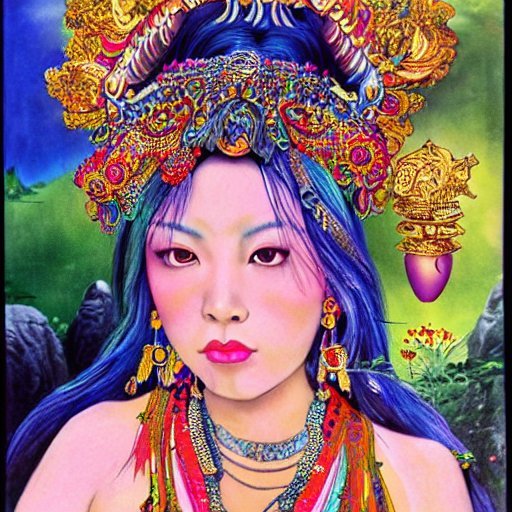
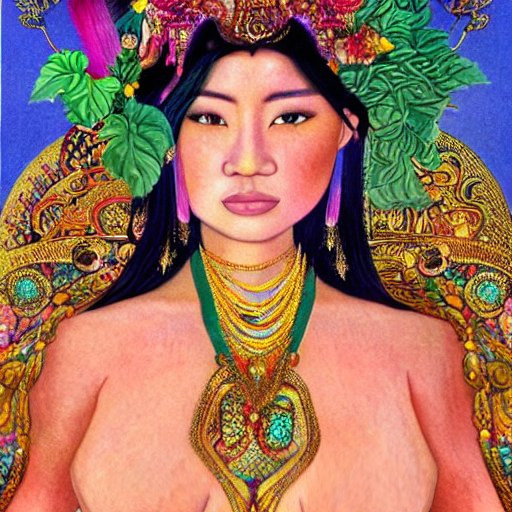


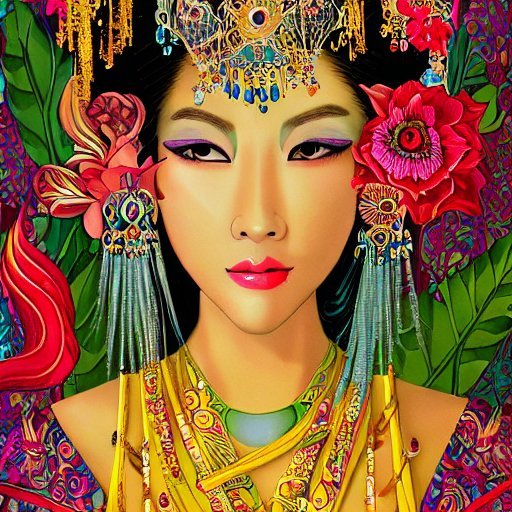

#ancient legends#ancient history#concept art#ancient religion#buddhist art#japanese folklore#filipino art#chinese folklore#filipino legends#filipino folklore#ancient china#ancient japan#esoteric#korean culture#korean legends#korean mythology#korean buddhism#korean folklore
0 notes
Text

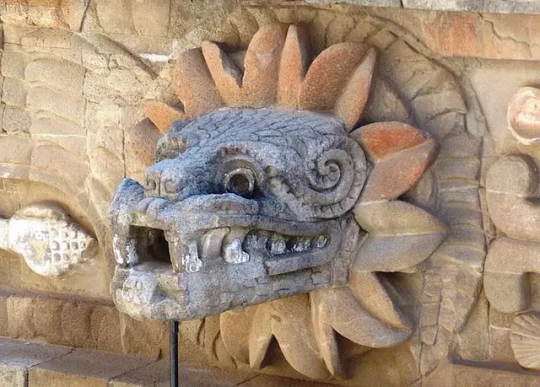
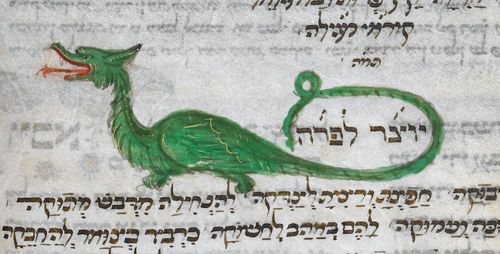
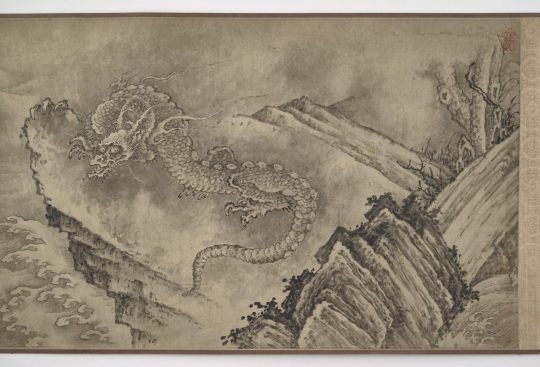

The Dragon Drags On
Though seldom seen today, dragons, of the genus Draconis, are some of the most famous creatures in the world, known for their size, ferocity, elegance, and supposed love for treasure. Though the exact number of dragon species is unknown, there are at least a dozen that are officially recognized; the real number is likely much higher. Once widespread, the range of this group has declined dramatically in the past centuries and populations are now believed to reside in only the most remote parts of the world. Most of what we know of dragons comes from historical records, and study of live specimens has proved impossible due to their rarity.
Because of their global distribution, dragons display a wide variety of morphological traits, including coloration, features, and even the number of limbs. However, some traits are common to nearly all species. Most dragons are thought to be brightly colored, often red, green, or blue; many species also have gold patterns in some form. As reptiles, dragons are covered in scales, though some also posses feathers or manes. Dragons also have extremely long, flexible tails which in some species may act as a supplementary limb. The body is generally long and serpant like, with the exception of the European Dragon and the mushhushshu, or Babylonian dragon. Though all species share an ability to fly, only the European dragon has a functional set of wings. The mechanics of flight for other species are unknown. The European dragon is also noted for its ability to breathe fire; other species such as the Chinese Dragon, or lóng, are more often associated with water.
All dragon species are believed to be carnivorous, though the content of their diet varies from region to region. Due to their large size, it is believed that they predate upon larger mammals such as cattle, sheep, camels, llama, deer, and even megafauna like elephants. Though they lack natural predators, their consistent targeting of livestock and game animals has in the past led dragons into conflict with humans; centuries of dragon hunting for sport and to protect agricultural interest has pushed the dragon to the brink of extinction.
Very little is known about the breeding habits of dragons. Like most large reptiles, they are believed to be solitary and fiercely territorial. It is also likely that they lay eggs, but whether parents provide any kind of care for their clutch or hatchlings is unknown. To date, no record of juvenile dragons has been found, indicating that the rate of survival to adulthood is extremely low. This may be due to predation on hatchlings by opportunistic animals, or adult dragons may attack and kill juveniles to defend their territory, or a combination of the two.
Although they are extremely rare today, dragons have been and continue to be important part of cultures around the world. Ancient civilizations such as the Aztec, Egyptians, and Mesopotamians all revered dragons as dieties. Many other cultures incorporated dragons into their folklore and mythologies, and in many parts of the world the dragon has come to symbolize power, changes in the seasons, or natural disasters, among other things. In more modern times, dragons have come to be associated with wealth, though there is no biological evidence for treasure-hoarding behavior.
Conservation status: Because no dragon species has been sighted for several centuries, they are largely believed to be extinct; however, the IUCN has yet to make a formal declaration. A few hopeful biologists believe that some species still survive in remote locations such as the deep Amazon rainforest or the mountains of Central Asia.
April Fools! I hope you enjoyed this departure from the usual content. I will be on hiatus until April 9th, as I'll be helping a friend with his field research. In the meantime, feel free to send in questions, commons, requests for a particular animal, or proof-of-donation submissions to help the people of Palestine; I'll respond to them all if I have spare time or when I get back!
Photos
A mosaic of a mushhushshu (Draconis babylonia) on the Ishtar Gate, constructed in the 6th century in Babylon; photo by Jan van der Crabben
A bust of an Amazonian dragon (Draconis quetzalcoatl) carved in 150-200 CE in Teotihuacan; photo via Wikimedia Commons
An illustration of a European Dragon (Draconis europa) from 15th century Italy, by the British Library
A Chinese dragon (Draconis qin) depicted as one of the eleven dragons in a Ming dynasty scroll, via the Smithsonian National Museum of Asian Art
A page from an illuminated manuscript of the Hamzanama, dated to the 16th century, showing a Persian dragon (Draconis mughal) via the Museum of Applied Arts in Vienna
103 notes
·
View notes
Text

Legends of the humanoids
Reptilian humanoids (3)
Dragon King – the god of water and dragons in Chinese mythology
Many dragons appear in Chinese folklore, of which the Dragon King is the leader. Also known as the Dragon God, the Dragon King is a prominent figure in Chinese art and religion. He is adopted by both Taoism and Buddhism and is the ruler of all water. Known as Long Wang in China, he has both human and dragon forms and can switch between dragon and human forms. Despite his intimidating and ferocious nature, Long Wan is regarded as a benevolent deity who brings good luck and chi energy to people living near the sea.
The Dragon King is a Chinese water and weather god. He is regarded as the dispenser of rain, commanding over all bodies of water. He is the collective personification of the ancient concept of the lóng in Chinese culture.
In East Asian cultures, dragons are most often shown as large, colorful snakelike creatures. While the dragons sometimes have qualities of a turtle or fish, they are most likely seen as enormous serpents.
While some named dragons are associated with specific colors, the dragon king can be shown in any shade. Like other Chinese dragons, he has a “horse-like” head, sharp horns and claws, and a hair-like beard.
Like many weather gods around the world, Long Wang was known for his fierce temper. It was said that he was so ferocious and uncontrollable that only the Jade Emperor, the supreme deity in Chinese Taoism, could command him. His human form reflects this ferocity. He is shown as a noble warrior in elaborate bright red robes. He usually has a fierce expression and poses with a sword.
During the Tang dynasty, the Dragon King was also associated with the worship of landowners and was seen as a guardian deity to protect homes and subdue tombs. Buddhist rain-making rituals were learnt in Tang dynasty China. The concept was introduced to Japan with esoteric Buddhism and was also practised as a ritual of the Yin-Yang path (Onmyōdō) in the Heian period.
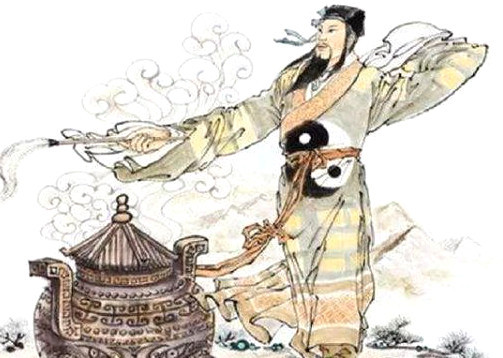
伝説のヒューマノイドたち
ヒト型爬虫類 (3)
龍王 〜 中国神話の水と龍の神
中国の民間伝承には多くのドラゴンが登場するが、龍王はそのリーダーである。龍神としても知られる龍王は、中国の芸術と宗教において著名な人物である。道教と仏教の双方に採用され、すべての水の支配者である。中国ではロンワンと呼ばれ、人間の姿と龍の姿の両方を持っており、ドラゴンと人間の姿を行き来することができる。その威圧的で獰猛な性格にもかかわらず、ロン・ワンは海の近くに住む人々に幸運と気のエネルギーをもたらす慈悲深い神とみなされている。
龍王は中国の水と天候の神である。彼は雨を降らせる神とされ、あらゆる水域を支配する。彼は中国文化における古代の「龍 (ロン)」の概念の集合的な擬人化である。
東アジアの文化では、龍は大きくてカラフルな蛇のような生き物として描かれることが多い。龍は亀や魚の性質を持つこともあるが、巨大な蛇として見られることが多い。
特定の色を連想させる龍もいるが、龍王はどのような色合いでも描かれる。他の中国の龍と同様、「馬のような」頭部を持ち、鋭い角と爪を持ち、髪の毛のようなひげを生やしている。彼の人間の姿はこの獰猛さを反映している。彼は精巧な真っ赤なローブを着た高貴な戦士として描かれている。通常、獰猛な表情を浮かべ、剣を持ってポーズをとる。
世界中の多くの気象の神々と同様、龍王は激しい気性で知られていた。あまりに獰猛で制御不能だったため、玉皇大帝にしか彼を指揮できなかったと言われている。
唐の時代、龍王はまた、大地主の崇拝と結びついて、家を守り、墓を鎮める守護神と見なされていた。仏教の雨乞いの儀式は、唐代の中国に学んだ。この概念は密教とともに日本に伝わり、平安時代には陰陽道の儀式としても行われていた。
#humanoids#legendary creatures#hybrids#hybrid beasts#cryptids#therianthropy#legend#mythology#folklore#s.f.#nature#art#dragon king#dragon god#chinese mythology#chinese dragon
131 notes
·
View notes
Text
A History of Vampires
Vampy vampy vampires! I’m not talking about Twilight; today I want to make a post talking about the real cultural significance of vampires in different folk beliefs around the world.
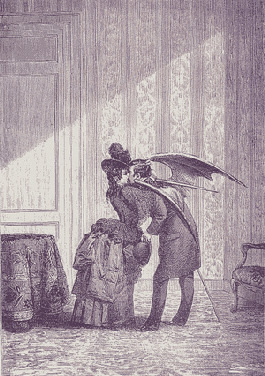
What Is A Vampire?
“...a mythical creature that subsists by feeding on the vital essence (generally in the form of blood) of the living.”
- Good ol’ Wikipedia
When we think of vampires, we picture Dracula in his brooding cloak sucking the life out of others. We see those characteristic fangs, an aversion to garlic, and a fatal vulnerability to sunlight.
Vampiric creatures have been noted in cultures around the world for generations.
A History of “Vampires” (Popularized in the West)
Cultures such as the Mesopotamians, Ancient Greeks, and Manipuri have folk tales of entities that are now considered to be precursors to modern-day vampires. Despite such occurrences of vampiric creatures in these ancient civilizations, the folklore for what most consider vampires today comes almost exclusively from early 18-thcentury Southeastern Europe.
The term “vampire” itself was popularized in Western Europe after reports of mass hysteria during the 18th-century. Said hysteria originated from a pre-existing folk belief in Southeastern and Eastern Europe that in some cases ended in corpses being staked, and some people were even persecuted under the accusation of vampirism.

Early folk beliefs in vampires has typically been summed up to pre-existing ignorance of how the body would decompose after death, with people attempting to explain such decay through the existence of vampires.
The more personable and charismatic version of the vampire, born in fiction, came in 1819 with the publication of The Vampyre by John Polidori. Bram Stoker’s novel Dracula in 1897 would later on provide the basis of the modern vampire legend and be remembered as the most significant vampire novel in literature. However, it is worth noting that Stoker’s novel came after the publication of the 1872 novel Carmilla, published by Irish author Sheridan Le Fanu.
Folk Beliefs
In Slavic and Chinese folk traditions, any corpse that was jumped over by an animal (especially a dog or cat) was feared to become a “vampire”. There was also believed to be a risk with a body having any wound that wasn’t treated with boiling water.
In Russian folklore, vampires were said to have been witches or people who had rebelled against the Russian Orthodox Church while alive.
Within Jewish traditions, “alukah” is synonymous with vampires. The creature is said to be a living human being, but can change into a wolf. It also has the ability to fly by releasing its long hair, and would eventually die if not allowed to feed on blood for an extended amount of time. Once dead, a vampire could be prevented from becoming a demon by being buried with its mouth stuffed with soil.
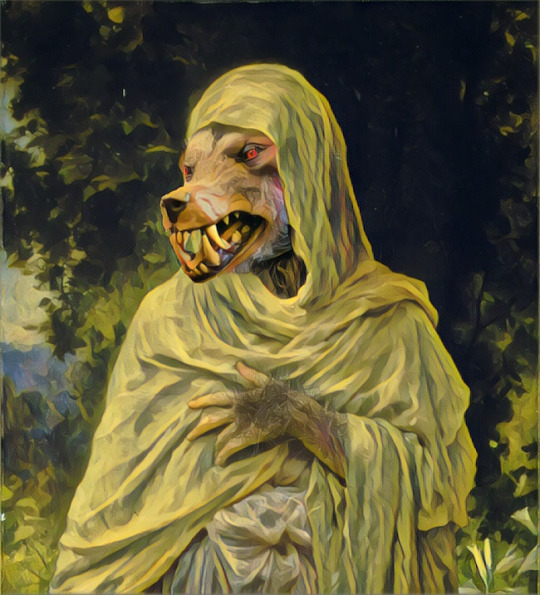
Albanian mythology discusses both the “shtriga” and the “dhampir”. Shtriga is a vampiric witch that sucks blood from infants while they sleep at night, then turning into a flying insect. Only a shtriga could cure those she drained blood from. A cross made of pig bone could be placed at the entrance of a church on Easter Sunday, which would render any shtriga inside unable to leave. Then, they could be captured and killed.
The Ashanti people in West Africa have folk tales of the iron-toothed and tree-dwelling “asanbosam” which can take the form of a firefly and hunts for children for their blood.
The Betsileo people of Madagascar have stories of “ramanga”, a vampire who drinks the blood and eats the nail clippings of nobles.
The Mapuche of southern Chile have stories of a bloodsucking snake known as “Peuchen”, with aloe vera being hung backwards behind or near a door to ward off vampiric entities across a variety of South American superstition.
Aztec mythology has folk tales of the Cihuateteo, which are skeletal-faced spirits of humans who died in childbirth. These entities were said to steal children, and entered into sexual liaisons with the living, which would drive them to insanity.
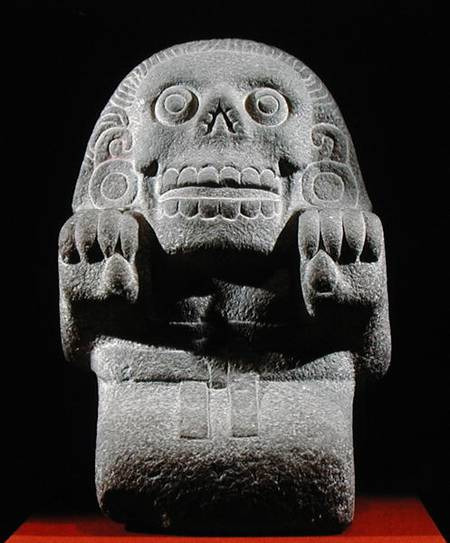
144 notes
·
View notes
Text
(this dude got lost in time and space again)
During this time, I have studied the vampires as a cultural phenomenon among various mythologies a little bit, so that I might get to know someone better (guess who it is the first time).
Therefore, here's interesting and intriguing facts about vampires, just for general development (or suddenly you want to write a "real vampire rei sakuma" au).
Well well~
1. Despite the reference of vampiric creatures in ancient civilizations, the folklore of the creature known today as the vampire originates almost exclusively from southeastern Europe of the early 18th century. At the same time, mass persecution of people on charges of vampirism began (this is probably what Rei says in one of the stories of the event when he talks about the persecution of his family. There are more and more hints that the Sakuma clan comes from from Europe).
2. In most cases, vampires (according to the beliefs, obviously) are the ghosts of evil creatures, suicide victims or witches, as well as people who died unnaturally, but they can also be created by an evil spirit inhabiting a corpse, or a vampire bite. In Slavic and Chinese traditions, any corpse that an animal jumped over, especially a dog or cat, could have become one of the undead (not really on the subject, but remember Koga and his dog Leon. it's just fun to think about it).
3. The vampires were lying in a coffin with their left eye open, wrapped in a shroud (Rei: —_O)
4. Judging by many mythologies, vampires suffer from arithmomania, that is, an acute need to count their actions or objects in the environment. For example, Chinese narratives say that if a vampiric creature came across a bag of rice, he would have to count every grain. This weakness was the human way to keep vampires in their coffins until morning.
5. According to folklore beliefs, corpses considered to be vampires usually looked healthier than expected, plump and with virtually no signs of decomposition. This is strikingly different from the pop-cultural image of a vampire depicted as a pale, thin, bony creature.
6. Folklore vampires could make their presence known by engaging in minor poltergeist-style activities such as throwing rocks at roofs or moving household items and pressuring people in their sleep (OMFG SECOND YEAR REI SAKUMA PFFT—)
7. One method of finding a vampire's grave involved leading a virgin boy through a graveyard or church grounds on a virgin stallion. The horse would supposedly balk at the grave in question (in the enstars canon, by the way, drinking the blood of a virgin boy was part of the Easter ritual of the Sakuma clan)
8. The objects that protected against vampires were garlic (which is more typical of European legends), sunlight (not always), wild rose stalk, hawthorn and various sacred things for believers. Some traditions also state that a vampire cannot enter a house without an invitation from the owner; after the first invitation, they can come and go whenever they want. (This, by the way, was repeatedly mentioned by Rei).
9. It is also believed that vampires avoid mirrors, since due to the absence of a soul, vampires don't have a reflection.
10. It is also believed in some cultures that vampires can send nightmares to people.

#ensemble stars#enstars#rei sakuma#as always don't ask me why you need to know#second year sakuma rei was on his way to becoming a folklore vampire LOL#Just think about how Rei is lying in a coffin with an open eye#strewn with wild rose petals of course
22 notes
·
View notes
Text
Into the Erlang-verse: Li, Zhao, Yang
-This is something I wrote for fun and reference purposes, back when I was starting to seriously get into Chinese mythology. As such, there is no citations, and is meant to be more of a general introduction to Erlang Shen in pre-modern writings.
(Emphasis on "pre-modern", because, as much as I love the Lotus Lantern + Prequel TV series, it's just a little frustrating to see people taking the shows' version as the end-all-be-all of such a complicated deity, y'know?)
-Anyways, much like Nezha, his Archery Accident Bro, Erlang has what I'd refer to as his "Pop Culture Form": Handsome three-eyed warrior god wielding a three-pronged spear, accompanied by his doggo Xiaotian Quan(Literally "Skyhowler"), going by the surname "Yang", jade emperor's nephew, etc.
-However, The Second Lad is an even messier amalgamation of deities worshiped in different parts of China, even in his supposed "home domain", Sichuan. Here, I'm only gonna talk about the most well-known and significant Erlangs.
(Not even gonna go into the possible Zoroastrian influences and the Dujian thing...)
1. Lord of Sichuan, "Li Erlang"
Key words: Hydraulic engineer, based on a historical official and his son, fierce competitor with Zhao Erlang for the Lord of Sichuan title
Weapons: Knowledge
Power: Can turn into a bull/dragon
Pets: N/A
"Who's Yang Jian? I've been watching over Sichuan since the Qin dynasty."
Li Bing was a pretty typical case of famous historical figure being worshiped as gods posthumously; born in the Warring States era, this official was put in charge of the Shu Prefecture (modern Chengdu) by King Zhao of Qin, and he was known as the creator of Dujiang Yan, an ancient irrigation + flood control project.

Later Tang legends deified him with a bunch of traditional "Flood-control hero" tropes taken from Yu the Great (heads up JTTW readers, SWK's staff is originally his extendable ruler), mostly the "hero turn into a giant animal" and "fight and subdue local water demons" aspect.
Though he wasn't yet known as an Erlang, or gained a son called Erlang as later folklore would have it, Li Bing's worship began in the Eastern Han dynasty, and he had a long tradition as Sichuan's guardian deity.
Even as later versions of Erlang began to populate, in the Qing dynasty, people of the province were still like "Our Lord of Sichuan is Li Bing/Li Erlang, not Yang Jian, as the novels would have you believe!"
What made Li Bing and his likely nonexistent son into "Li Erlang" could be traced to the two "warlord states" that occupied Sichuan after the fall of Tang dynasty: both states tried to use the Lord of Sichuan worship to strengthen their own legitimacy, and passed decrees that 1) said Erlang was Li Bing's son and 2) granted both father and son honorable titles, as mentioned in Song dynasty records.
However, due to the association of Erlang with previous warlord states, the first emperor of Song had reassigned Li Bing a lesser title and taken away his son's title altogether, reducing him to just "God of Guankou", and worshippers were quite disgruntled by the change; there was even a rebellion using the Guankou worship rituals to legitimize itself, a decade after said emperor's death.
Fun fact: when I went to the Two Lord’s Temple (of Li Bing and Li Erlang) in Dujiangyan, even though the god worshipped in the main hall was supposed to be Li Erlang, the plaque next to it still said something like "Li Erlang, also known as Yang Jian"...
Which really shows just how influential FSYY is on popular worship, to the point of overshadowing older incarnations of certain deities.
2. Immortal Master of Illustrious Sagacity, "Zhao Erlang"
Key words: Chief of Jiazhou Prefecture, dragon slayer, No.2 violator of archery safety (first place goes to Nezha)
Weapons: A scribing tablet, slingshot, sword, bow and arrows
Power: Supernatural strength, monstrous giant form
Pets: unnamed white horse, hunting hawks and hounds
"C'mon, my aim isn't that bad! What happened in the Zaju was a one-time thing!"
The prototypical Taoist Erlang, his name, "Zhao Yu"(赵昱) first appeared in a Song dynasty source. At this point, the story of Erlang was mainly defined by two traits: 1) was, or was related to an official in charge of Sichuan in bygone times and 2) Did heroic flood control stuff, probably through dragon-slaying.
One notable strand of local worship was the "God of Guankou"; historical records mentioned that people sacrificed hundreds and hundreds of goats to him, as well as a regional festival in Sichuan where people played out his confrontation with dragons. It coexisted and entwined with the "Lord of Sichuan" worship, until the Song dynasty.
In typical Song dynasty fashion, the officials decided to give their own official title to this...Erlang/Lord of Sichuan/God of Guankou guy, bringing our titular "Zhao Erlang" into existence.
Also a deified official from the Tang dynasty, his image was more heavily influenced by Taoism (historically popular in Sichuan) and centered around one of its holy places, Mt. Qingcheng, which just happened to be quite close to Dujiang Yan.
Though in the Northern Song dynasty, the state-recognized Erlang was still "Li Erlang", the Taoist Zhao Erlang had proven himself to be a strong competitor by the Southern Song and Yuan dynasty, thanks to a massive amount of opera plays.
First we have SJSSDQ (三教搜神大全, Yuan Dynasty), an encyclopedia of Buddhist, Taoist and Confucian gods, where his traditional backstory as an ascended mortal official was combined with the dragon-slaying feat to nudge Erlang toward a more warrior-esque image, a hunting god who appeared on a white horse with his entourage of hunters.

-We also got the first mention of what would become his six/seven sworn brothers; the "Seven Sages" who jumped into the water to assist him in the dragon fight.
Then we have two Yuan-Ming Zaju plays, "Erlang of Guankou Slays the Jian-jiao"(灌口二郎斩健蛟) and "Erlang Drunkenly Shot the Demon-locking Mirror" (二郎神醉射锁魔镜), in which many traits associated with JTTW's Yang Erlang could already be seen: first, his three-pronged weapon, seven brothers and bow/arrows, second, the naming of his brothers as the "Seven Sages of Mt. Mei" and his ability to shift into a "true form", aka the monstrous giant form he used in JTTW.
(The plot of the second Zaju is exactly like it sounds: Erlang and Nezha had a drunken archery competition, accidentally broke the Demon-locking Mirror and released the Bull Demon King + Hundred-Eyed Demon, and spent the rest of the play doing damage control.)
3. The Little Sage, "Yang Erlang" (JTTW)
Key words: Jade Emperor's nephew, cleaver of Peach Mountain, SWK's true equal in battle
Weapons: Three-pronged, Double-bladed Spear, slingshot, bow and arrows, axe
Power: transformations, Cosmic Body, divine sight/Phoenix Eye(?)
Pets: a celestial Xiquan, literally "Thin Dog"
"First time we met, and that monkey made fun of my origins as a conversation opener. Could you believe it."
The Man, The Myth, The Legend! As I said before, a lot of his traits were inherited from "Zhao Erlang", including his Taoist title, his temple at Guankou, etc.
However, Erlang being Jade Emperor's nephew seemed to be mostly popularized by JTTW: the only other work that might have given Erlang this backstory was The Precious Scroll of Erlang, previously dated to the 1560s, though a Chinese paper published in 2018 proposed a later creation date (1620s).

Much like JTTW Nezha, his backstory was somewhat barebones: we knew from SWK's taunt that his mother was the Jade Emperor's sister, who got chummy with Yang the mortal, gave birth to him, and was presumably locked under the Peach Mountain for that, bc Erlang then rescued her by cleaving it in half with an ax.
(Sounds familiar? The same backstory would later be copied over to Erlang's nephew, in the Lotus Lantern legends)
His other notable feats include falling 2 phoenix with his slingshot, as well as slaying the "Seven Demons of Mt. Mei ''. Out of pride, he chose to remain in Guankou instead of associating with his heavenly relatives, and did not answer to general summons to court from the Jade Emperor, only taking special assignments (听调不听宣).
Apart from his famous fight with SWK, Erlang also appeared in JTTW chapter 63, where, together with his sworn brothers, he helped the pilgrims fight the Nine-Headed Wyrm, son-in-law of Bibo Lake's dragon king. His dog continues to be the MVP in this fight, biting off one of the demon's heads, leaving it wounded and fleeing toward the north sea.
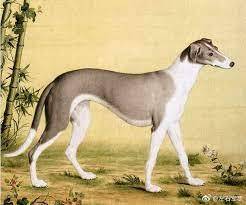
Though the description of his battle with SWK implied that he did have some sort of supernatural sight, at this point in time (Ming dynasty), Erlang wasn't yet depicted with a third eye in artworks and literature.
There are a small amount of evidence that suggest the third eye thing might have shown up in statues of this period, though.

4. Master of the Ninefold Mystic Way, "Yang Jian" (FSYY)
Key words: Disciple of the Taoist sage Yuding, veteran of the Investiture War, Nezha's comrade-in-arms
Weapons: Three-pronged Spear, slingshot
Power: Ninefold Mystic Way, 72 transformations, invulnerable to physical attacks, Samadhi Fire (in FSYY it's on the same level as a D&D wizard's Fireball spell)
Pets: Howling Celestial Dog, unnamed white horse
"I fought a transforming monkey demon too!"
Fun fact: the guy whose name was most often taken as Erlang's "real name" by pop culture was never actually referred to as "Erlang" in his debut novel. Could ya believe it.
Quick, dirty summary of FSYY: kinda like the Chinese Iliad, about the overthrowing of Shang dynasty and its tyrannical King Zhou by King Wu of Zhou, with a dash of Taoist infightings, and almost everyone who died in the fight got revived as gods and became part of the celestial bureaucracy, thus "Investiture of the Gods".
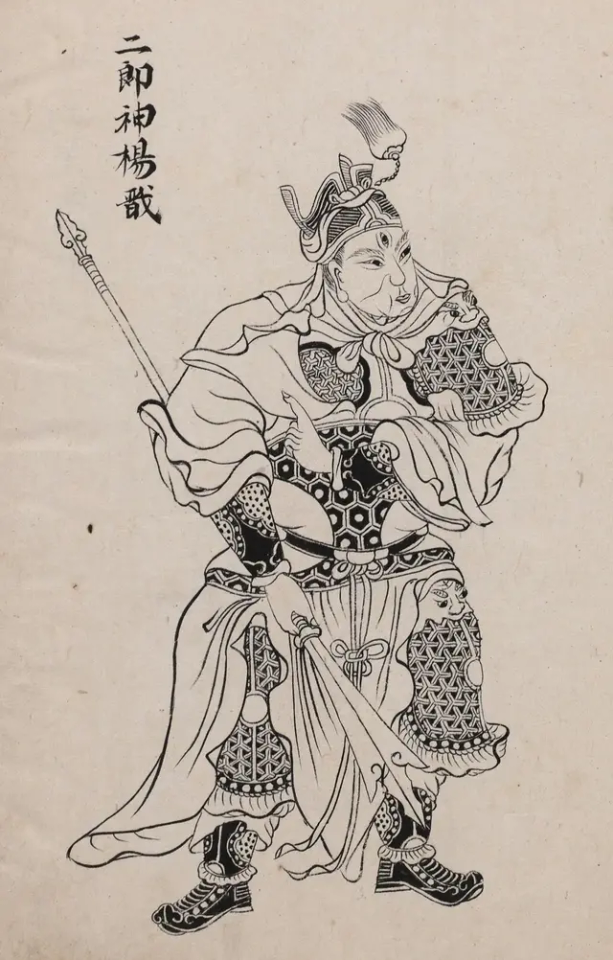
Under the order of his master, the Taoist sage Yuding (literally "jade tripod"), Yang Jian makes his first cameo in chapter 40 to assist his senior, Jiang Ziya, in the fight against the Four Generals of Clan Mo.
A master in the arts of the Ninefold Mystic Way and 72 transformations, he has the same divine title as Zhao Erlang and is considered "A Sage in Flesh" after the end of FSYY.
As such, he's able to survive getting eaten by a monstrous weasel, a metal whip in the forehead, graphic disembowelment, etc. and used his transformation skills for some SWK-style "beating people up from inside their stomachs".
On one very notable occasion, he transformed into a beautiful palace consort to dupe Tu Xingsun ("Earth-traveling Son") and capture him.
Oh, and also, on his way to get Tu Xingsun's master, he ran into this random demon in a lake, who led him into a cave. After he got inside, the demon just disappeared, leaving him with the Three-pronged Two-bladed Spear, as well as some nice bling.
Then two kids burst in, accused him of stealing the bling, and...instantly became his students after learning his name? Yeah that was a weird sidequest.
However, Yang Jian's most iconic battle is probably his fight with Yuan Hong, the White Ape of Plum Mountain...who also practiced the Ninefold Mystics, used an iron cudgel, and were sworn brothers with six/seven demon kings.
Only with the help of Nvwa's magical painting, the Shanhe Sheji Scroll, was Yang Jian able to capture the ape, and subsequently, let Jiang Ziya decapitate him with Sage Luya's Immortal Slaying Flying Knife.
When the Three Demonesses were caught and executed at the end of the book, he was the one responsible for slaying the Nine-headed Pheasant Demoness, which is a neat parallel with JTTW.
His Howling Celestial Dog appears in chapter 47, and is even more of an MVP in fights: 12 immortals and demons have been bitten by this dog, which was "as large as a white elephant and as swift as an owl".
Funnily enough, every time Yang Jian summoned his hound, it is described in the same way as, say, other immortals may summon a flying sword, and my mental image is just him yeeting his giant monster dog at the enemy like you'd throw a Pokeball.
(A list of everyone Xiaotian had bitten in FSYY: Zhao Gongming, his sister Bixiao, Xinhuan, Deng Chanyu, Zhou Xin, Hua Huan, the Winged Immortal, Yuyan, Lv Yue, Yu Hualong, Dai Li the dog demon, the Nine-headed Pheasant Demon.)
Conclusion:
-The way I see it: Li is the Erlang of regional worship, Zhao is the Erlang of Zaju plays, and Yang is the Erlang of vernacular novels, who becomes super popular and overshadows his two predecessors.
-And Erlang's depiction in premodern Lotus Lantern tales is what we in the business call "a whole new can of worms". But that's a series for another day.
#erlang shen#chinese mythology#chinese folklore#journey to the west#investiture of the gods#fengshen yanyi#xiyouji#yang jian
18 notes
·
View notes
Text
City God: A Special State Cult, Between Religion and Bureaucracy
The philosophical and magical context of this practice is shamanic. At the same time, its implementation appeals to the Taoist celestial hierarchies and state bureaucracy.

View On WordPress
#ancient China#Chinese architecture#Chinese culture#Chinese customs#Chinese folk religion#Chinese history#Chinese mythology#Ming dynasty#Qing dynasty#Taoism#Taoist deities#Taoist practices#chinese art#chinese philosophy#City God#urban#city#chinese folklore#ancestral#ancestral worship#polytheism#deities#gods#mythology#myths#spirits
10 notes
·
View notes
Text

24 - Jīnwū
The three-legged crow is a mythological creature in various mythologies and arts of East Asia. It is believed to inhabit and represent the Sun. In Chinese mythology and culture in particular, the three-legged crow is called the sanzuwu and is present in many myths. The sanzuwu in a disc represents the sun and is also one of the Twelve Ornaments that is used in the decoration of formal imperial garments in ancient China.
The most popular depiction and myth of a sanzuwu is that of a sun crow called the Yangwu or more commonly referred to as the Jīnwū or "golden crow". Even though it is described as a crow or raven, it is usually coloured red instead of black. According to folklore, there were originally ten sun crows which settled in 10 separate suns. They perched on a red mulberry tree called the Fusang, said to have many mouths opening from its branches. Each day one of the sun crows would be rostered to travel around the world on a carriage, driven by Xihe, the mother of the suns. The sun crows would often descend from heaven on to the earth and feast on the grasses there, but Xihe did not like this; thus, she covered their eyes to prevent them from doing so. Around 2170 BC, all ten sun crows came out on the same day, causing the world to burn; Houyi, the celestial archer, saved the day by shooting down all but one of the sun crows.
29 notes
·
View notes
Text
2024 - The Year of the Dragon: A Majestic Journey Begins
Shaina Tranquilino
January 4, 2024
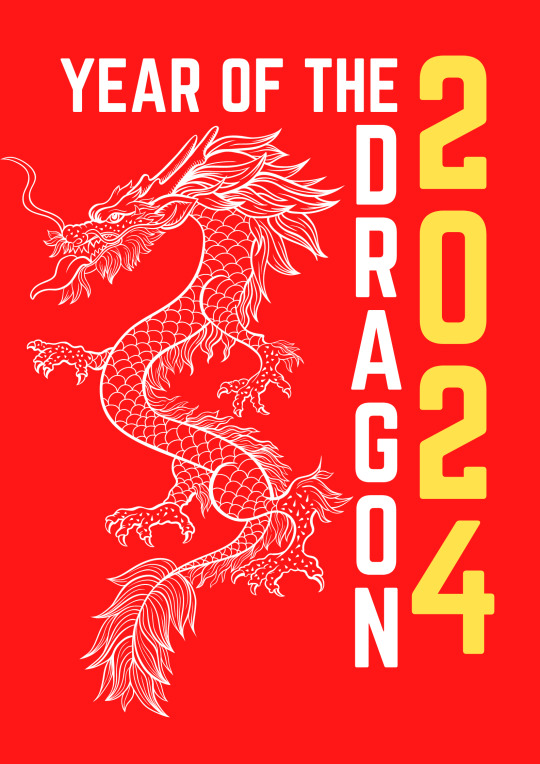
In Chinese culture, each year is associated with a zodiac animal, which is believed to have certain qualities and characteristics that influence the events and lives of people born in that year. Amongst these twelve animals, one holds a special place of honor and reverence – the mighty dragon. Known for its power, wisdom, and good fortune, the Year of the Dragon is met with great anticipation and excitement by millions around the world. Let's delve into this awe-inspiring year and discover what makes it so extraordinary.
1. Symbolism and Significance:
The dragon symbolizes many virtues deeply valued in Chinese culture. It represents strength, prosperity, wisdom, success, and luck. Dragons are often seen as guardians or protectors who bring harmony and blessings to those they encounter. With such auspicious associations, individuals born in the Year of the Dragon are considered particularly fortunate.
2. Personality Traits:
People born under the sign of the dragon are known for their ambitious nature and unwavering determination. They possess strong leadership abilities and tend to stand out from the crowd due to their confident demeanour. Dragons are highly intelligent and innovative thinkers, always seeking new challenges to conquer. Their charisma captivates others effortlessly.
3. Historical Significance:
The Year of the Dragon has a rich historical significance that transcends cultural boundaries. In ancient Chinese dynasties, emperors were believed to be direct descendants of dragons; thus, this zodiac sign was closely associated with imperial power and authority. Throughout history, many significant events have occurred during dragon years, making them even more intriguing.
4. Economic Prosperity:
Just as dragons bring good fortune in folklore tales, their presence in a zodiac year is often accompanied by economic growth and prosperity. People believe that starting new ventures or making important investments during a dragon year can yield favourable outcomes. Businesses thrive, careers flourish, and financial abundance becomes more attainable.
5. Celebrations and Festivities:
The arrival of the Year of the Dragon is marked by vibrant celebrations and traditional festivities that span over several weeks. The most notable amongst these is the Spring Festival, commonly known as Chinese New Year. Streets are adorned with colourful decorations, firework displays light up the night sky, and families gather to share special meals, exchange gifts, and honour their ancestors.
As we embark on the Year of the Dragon, a sense of excitement permeates the air. This majestic creature brings hope, prosperity, and new beginnings for all who embrace its energy. Whether you were born in this auspicious year or not, it's an opportunity to tap into your inner strength, courageously pursue your dreams, and seek out the limitless possibilities that lie ahead. May this year be one filled with success, wisdom, and good fortune for us all!
So let us embrace this celestial guardian and embark on a journey full of wonder as we navigate through the Year of the Dragon!
#2024#year of the dragon#Chinese astrology#dragon year#mythical creatures#new beginnings#dragon energy#celestial signs#zodiac magic#elemental power#ancient wisdom#new year#happy new year#happy new year 2024#year of the dragon 2024
14 notes
·
View notes
Text
Folklore Fact - Christmas Trees!
It's Christmastime! The most wonderful time of the year! And after holding a festive poll on my Patreon, Christmas trees are the very clear winner for this month's folklore fact. Let's dive right in...

(Couldn't resist)
There are a lot of different theories about Christmas trees. All kinds of concepts about how they might've originated, who had them first - so let's start at the "beginning," per se.
First off, various sources - including most prominently the Encyclopedia Britannica - mention that many cultures saw evergreens as representing eternal life. Makes sense, given they're always green. The ancient Egyptians, Chinese, and Hebrews used evergreen garlands, trees, and - yes - wreaths to symbolize eternal life, and they were used in worship.
Likewise, worship of trees was common among Scandinavian cultures and many other European cultures besides; for instance, the great tree at the Temple at Uppsala was said to be evergreen and was where sacrifices were hanged (including men, horses, dogs, and others)...

(sacrifices hanging in the trees at the temple at Uppsala)
Continuing the sacredness of trees in Scandinavian cultures, decorating the house with evergreens at the end of the year warded away the devil, and sometimes trees were set up for birds to nest in during Christmas time. There was also the very important Yule log during the time of Yule, although that was a log to burn, not a tree. The Yule log is still a tradition today.
However, none of this is the same as bringing a tree into your home and decorating it with candles, gold, and whatever else - and certainly not hanging sacrifices on it. So what really started the Christmas tree we have today?

The evergreen was kind of always specifically related to sanctity and everlasting life in Christianity. After Donar's Oak (a sacred pagan tree) was felled by the Christian Saint Boniface and his retinue, some later versions of the tale include an evergreen growing in its place, its triangular shape representing the Holy Trinity. Likewise, we have Roman sources mentioning Christians decorating their homes in evergreens.
Decorated trees and evergreen elements appear throughout Christian lore over many time periods. For instance, Christmas trees have often been equated to the "tree of paradise" found in the mystery plays of the Middle Ages, which were held on what is now Christmas Eve (December 24). A tree decorated with apples - the forbidden fruit of original sin, which Christ took away - and white wafers (redemption and the Eucharist) was used in plays about Adam and Eve on their name day. Later, this tree was placed in homes, and the red apples became shiny red balls - the same ones we know and love today. It's entirely possible these were our first Christmas trees.
It is often thought the first reference to real "Christmas trees" appears toward the end of the medieval period in the 15th century in the writings of the Regiment of the Cistercian Alcobaça Monastery in Portugal...
"Note on how to put the Christmas branch, scilicet: On the Christmas eve, you will look for a large Branch of green laurel, and you shall reap many red oranges, and place them on the branches that come of the laurel, specifically as you have seen, and in every orange you shall put a candle, and hang the Branch by a rope in the pole, which shall be by the candle of the high altar."
Many of these traditions still live on today.
Generally, Christmas trees are considered to be largely in the Baltic regions and Central Europe. Some people also ascribe the Christmas tree to Martin Luther, who may have been the first to add candles to decorating trees. There is also a representation of a Christmas tree in a keystone sculpture of a home in Turckheim, Alsace (part of France today, formerly in the Holy Roman Empire of the German Nation). This dates to 1576.
So, are there pre-Christian origins to the Christmas tree? Maybe, as depending upon whom you ask, it did depend on region and denomination in the past - but it's also possible that it was a separate Christian concept and originated from the tale of Adam and Eve and the redemption brought by Jesus Christ, originating even before what some scholars consider to be the first real representations of Christmas trees.
We can't "prove," necessarily, that the evergreens of Christianity came from any one particular previous source. Although all cultures that became Christian were certainly influenced by their previous customs, it could've also been something that originated independently in Christian culture or came about influenced by not one but multiple concepts and cultures. No other culture quite approached it the exact same way as did Christians, same as they never fully approached it the same way among one another. There are many cases of similar traditions developing independently, as is already evident in the idea of evergreen representing eternal life (which of course makes sense) across many cultures that had little or no communication with each other during these time periods.
So... who knows! It was and is a subject of debate among scholars. Either way, the Christmas tree is now undeniably an important part of Christmas and the Christmas season. It just isn't Christmas without the trees.
And that's this year's Christmas folklore fact! If that really counts as folklore. Religious fact? Anyway!
Until next time, and I truly wish everyone a very merry Christmas and a wonderful new year! It's the best time of the year, and I hope it's fantastic for us all.
P.S.: Please don't use this post as a jumping off point to attack any particular set of beliefs/religion. Be nice. It's Christmas. Thanks in advance.
( If you like my blog, be sure to follow me here and elsewhere for more folklore and fiction, including books, especially on werewolves! You can also sign up for my free newsletter for monthly werewolf/vampire/folklore facts, as well as free fiction and nonfiction book previews. You'll be the first to hear about everything, without having to check social media!
Free Newsletter — maverickwerewolf.com (personal site + book shop) — Patreon — Wulfgard — Werewolf Fact Masterlist — Twitter — Vampire Fact Masterlist — Amazon Author page )
#folklore#folklore fact#Christmas#Christmas tree#Christmas trees#xmas#Norse mythology#Norse myth#folklore thursday#folklorethursday#legends#myths and legends#Thor#mythology#pagan#Christianity#Christian#holiday#holidays#traditions
16 notes
·
View notes